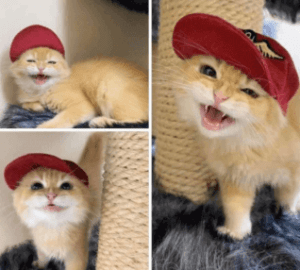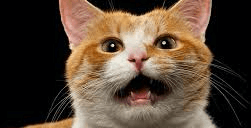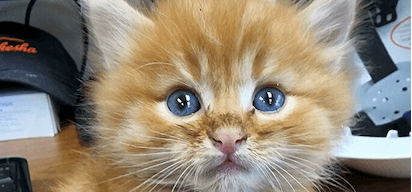Herbivores have a high ability to extract nutrition from plant matter as the result of their capability to ferment it, and therefore they have been found to have a high coefficient of fermentation. Carnivores however, aren’t equipped to do this and therefore have a low coefficient of fermentation.
The large intestine (colon) of carnivores is simple and very short, as its only purposes are to absorb salt and water. It is approximately the same diameter as the small intestine and, consequently, has a limited capacity to function as a reservoir to hold and ferment/digest vegetable matter, grains or cooked food. The colon is short and non-pouched. The muscle is distributed throughout the wall, giving the colon a smooth cylindrical appearance. Although a bacterial population is present in the colon of carnivores, its activities are essentially putrefactive.
Experts agree that wolves and wild cats only eat the stomach contents of their prey when the prey is quite small and it gets consumed as a result of eating the entire animal (like a rabbit for example).
L. David Mech, is considered the world’s top wolf biologist. In his book ‘Wolves: Behavior, Ecology, and Conservation’ (2003) (and I have read and studied all his books among other so-called experts and I’ve observed wolves in the wild as well in my 20’s), he and other contributing experts compiled over 300 years of research and observations of the wild canine. An excerpt from this informative work clearly portrays the natural, instinctive eating behavior of the carnivore. “Wolves usually tear into the body cavity of large prey and consume the larger internal organs, such as lungs, heart, and liver. The larger rumen/intestines [one of the main stomach chambers] is usually punctured during removal and its contents shaken out or spilled. The vegetation in the intestinal tract is of no interest to the wolves nor wild cats, but the stomach lining and intestinal wall are consumed, and their contents further strewn about the kill site.“
The Kerwood Wildlife Education center (Hunting and Meals pages) describes the eating habits of the wolf as: “The wolf’s diet consists mostly of muscle meat and fatty tissue from various animals. Heart, lung, liver, intestines and other internal organs are eaten. Bones are crushed to get to the marrow, and bone fragments are eaten as well.” The only part consistently ignored is the stomach itself and its contents. Although some plant matter (not vegetables) is taken separately, particularly berries, Canis Lupis doesn’t seem to digest them very well.” I have personally seen undigested berries come out into a wolf’s stool. Even my own dogs when I’ve fed them 2% to 3% of fruit away from their protein/organ/eggshell diet [proper complete raw diet] – I’ve seen undigested pieces of apples & pears in their stool including puppies.
Thus, feeding dogs and cats as though they were humans (omnivores) taxes the pancreas and places extra strain on it, as it must work harder (or more) for the dog or cat to digest the starchy, carbohydrate-filled food, vegetables and cooked food instead of just producing the normal amounts of the enzymes needed to digest raw animal proteins and fats.
Our dogs and cats do not have the kinds of enzymes or friendly bacteria that break down cellulose and starch for them as we humans/omnivores do. As a result, most of the nutrients contained in plant matter – even pre-processed plant matter – are unavailable to dogs and cats (they receive very little to none of the nutrients from vegetables, no matter what you do to them). This is why dog and cat food manufacturers have to add such high amounts of synthetic vitamins and minerals (the fact that cooking destroys all the vitamins and minerals and thus creates the need for supplementation aside) to their dog and cat foods. To compensate for this, the manufacturer must add a higher concentration of vitamins and minerals than the dog and cat actually needs.
The result of feeding dogs and cats a highly processed, vegetable and grain-based food is a suppressed immune system and the under-production of the enzymes necessary to thoroughly digest raw meaty bones.
Dogs are so much like wolves physiologically that they are frequently used in wolf studies as a physiological model for wolf body processes. (Mech, L.D. 2003. Wolves: Behavior, Ecology, and Conservation). All wild cats have the identical internal organs, thus domestic cats when you study their anatomy & physiology as well, you will see that their internal organs are identical to their wild ancestor, and work identically in “healthy” domestic cats as well.
Additionally, dogs and wolves share 99.8% of their mitochondrial DNA (Wayne, R.K. Molecular Evolution of the Dog Family). Cats are 99% identical DNA to their wild ancestor cats.
This next quote is from Robert K. Wayne, Ph.D., and his discussion on canine genetics (taken from
www.fiu.edu/~milesk/Genetics.html). “The domestic dog is an extremely close relative of the gray wolf, differing from it by at most 0.2% of DNA sequence…”
Dogs have been reclassified as Canis lupus familiaris by the Smithsonian Institute (Wayne, R.K. “What is a Wolfdog?”(
www.fiu.edu/~milesk/Genetics.html), placing it in
the same species as the gray wolf, Canis lupus. The dog is, by all scientific standards and by evolutionary history, a domesticated wolf. And although many don’t want to hear about God in anything anymore whether for human beings or anything else, dogs & cats were always designed as carnivores eons of thousands of years ago when they were domesticated and they have not “evolved” into these animals where their internal organs have ever and will never change(neither have humans) so they are true carnivores.
(Feldhamer, G.A. 1999. Mammology: Adaptation, Diversity, and Ecology. McGraw-Hill. pg 472.). And domestic cats since they have always been obligate carnivores/felines they will always remain carnivores.
Those who insist dogs did not descend from wolves must disprove the litany of scientific evidence that concludes wolves are the ancestors of dogs. And, as we have already established, the wolf is a carnivore. Since a dog’s internal physiology does not differ from a wolf, dogs have the same physiological and nutritional needs as those carnivorous predators and cat’s internal physiology does not differ from any wild cat on the planet, so since their wild ancestors are obligate carnivores so are domestic cats, which, remember, “need to ingest all the major parts of their herbivorous prey, except the plants in the digestive system” to “grow and maintain their own bodies” (Mech, L.D. 2003. Wolves: Behavior, Ecology, and Conservation.). I have not listed any books for cats because although I have many of them to reference from I don’t have them memorized like I do with many wolf books. (If you want me to look them up after I move back to Upstate NY – then I will look them up when I unpack them after settling in sometime in Sept. or Oct. 2019)
However much, we humans have done to tinker with, and change, the dog’s & cat’s body design (resulting in varying sizes and conformations), we have done nothing to change the internal anatomy and physiology of our carnivorous canines. (came with human beings – our internal organs have always been the same and will remain the same – they will never change!) “Dogs and cats have the internal anatomy and physiology of a carnivore”. (Feldhamer, G.A. 1999. Mammology: Adaptation, Diversity, and Ecology. McGraw-Hill. pg 260 for dogs/wolves) — other books for cats I can get to them later but really I don’t even need these books when I’ve studied them for so long – you just have to know the anatomy & physiology of cats as well as dogs).
Some people are under the impression that the bacteria in raw meat may harm a dog and cat this simply is not the case.
Sadly, raw diets have also been blamed for causing things like pancreatitis and kidney disease, when in reality the underlying dis-ease/(disease) was already there and is/was simply brought to light by the change in diet and detoxing or going through a healing crisis.
Dogs and cats are surprisingly well-equipped to deal with bacteria. Their saliva has antibacterial properties; it contains lysozyme, an enzyme that destroys harmful bacteria. Their short digestive tract is designed to push through food and bacteria quickly without giving bacteria time to colonize. The extremely acidic environment in the gut is also a good bacteria colonization deterrent. People often point to the fact that dogs and cats can shed salmonella in their feces, (but, then again, even kibble-fed dogs and cats do this as well!) without showing any ill effects as proof that the dog and cat is infected with salmonella. In reality, all this proves is that the dog and cat has effectively passed the salmonella through its system with no problems. Yes, the dog and cat can act as a salmonella carrier, but the solution is simple – do not eat dog or cat poop and wash your hands after picking up after your dog or cat.
As mentioned above, even kibble-fed (processed commercial diets) dogs and cats can and do regularly shed salmonella and other bacteria. Most of the documented cases of severe bacterial septicemia are from kibble-fed animals or animals suffering from reactions to vaccines not raw fed. (and although the FDA in recent years is attacking smaller raw food companies – don’t let the FDA fool you – your dogs & cats bodies have always been designed to eating raw meat/organs/bones (or powdered egg shells for calcium).
Commercial pet foods have been pulled off shelves often because of bacteria AND molds that produce a deadly toxin.
What is the solution? Use common sense. Clean up well and wash your hands. Think about your dog and cat, this is an animal that can lick itself, lick other dogs and cats, eat a variety of disgusting rotting things, and ingest its own feces or those of other animals with no ill effects. The dog and cat especially “healthy” ones, plain and simple, has been designed to handle far greater bacterial loads than we can.
Let’s face it; a healthy dog and cat will not suffer from bacterial infections or bacterial septicemia. It is just common sense. A dog or cat suffering from “salmonella poisoning” is obviously not healthy, especially when compared to a dog or cat that ate the same food with the same salmonella load but is perfectly healthy and unaffected. The first dog or cat has suffered a ‘breakdown’ in its health that allowed the bacteria to become a problem; if one is talking in homeopathic medicine terminology, this is simply one more symptom that shows the dog is suffering from chronic disease.
I believe that it is the kibble, not the raw meat, that causes bacterial problems. Kibble in the pet’s intestine not only irritates the lining of the bowels, but also provides the perfect warm, wet environment with plenty of undigested sugars and starches as food for bacteria. This is why thousands of processed food-fed animals suffer from a condition called Small Intestinal Bacterial Overgrowth, or SIBO. Raw meaty bones, however create a very inhospitable environment for bacteria, as RMBs are easily digestible and have no carbohydrates, starches, or sugars to feed the bacteria. And in Kibble fed mainly large breed dogs(& x-large breeds) dry kibble is the MAIN cause of BLOAT! It sits in their stomachs far too long, causing gas to emit from the dry kibble digesting in the stomach (usually takes 8 to 12 hours to digest when normal raw meat/organs/bones or powdered egg shells only takes 3 to 5 hours in a healthy dog – and only 2 to 3 hours in healthy cats) which then caused BLOAT which can be DEADLY to many dogs – many have died on the operating table from emergency surgery.

















